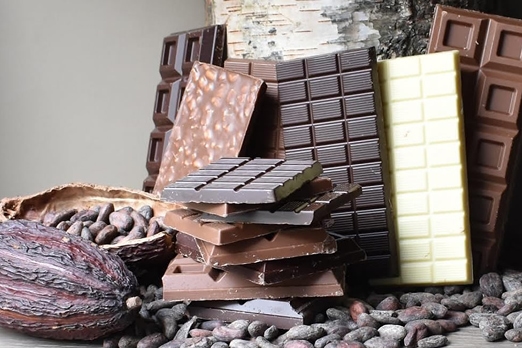Chocolate: a triumph of emotions that melts in your mouth
What makes a chocolate melt irresistibly in your mouth? And more importantly, what emotions lead you to the pantry where you keep your black gold? Let’s find out together!

Chocolate: faithful everyday ally, versatile friend in the kitchen, and an enveloping sensory experience. We find dozens of kinds on the supermarket shelves and sometimes even in our pantries: with different percentages of cocoa, crunchy, with a creamy center, with nuts, with spices, and so on! Nevertheless, one of the characteristics for which chocolate is particularly famous is its ability to melt in your mouth, leaving behind a pleasantly enveloping sensation.
A famous brand has even turned this characteristic into its forte! Together let’s discover what gives chocolate this characteristic!
WHY DOES CHOCOLATE MELT SO WELL IN THE MOUTH?
Chocolate is made from the seeds that are found in the fruit of cocoa beans. These seeds undergo a process of partial fermentation, drying, roasting, and grinding. Once this first phase is over, the ground product that’s obtained is pressed in order to extract the fats which it contains. It’s these fats that give chocolate its final melty quality and the method with which it’s processed modulates its characteristics.
On the contrary to animal fats, like those in butter or bacon, which melt at very different temperatures from one another, the melting temperature of cocoa butter is between 32°C and 36°C, just slightly lower than our body temperature. This characteristic is due to the presence of three primary triglycerides whose building blocks are mainly saturated fats with a higher melting point than unsaturated fats.
The second characteristic which makes chocolate more or less melty is the overall size of the particles of which it’s made up. Dark chocolate is made up of cocoa powder, cocoa butter, sugar, and sometimes certain emulsifiers.
The smaller the particles of these ingredients, the less friction they create in our mouth and the more the chocolate is perceived as velvety, creamy, and melty!

Swiss chocolate, which has very fine particles, is obtained through a unique technology invented by Rodolphe Lindt in 1897.
Mr. Lindt developed a pressing method (conching) that was capable of obtaining a well-blended and homogeneous “mixture” of powder and cocoa butter. It’s thanks to this pressing method that Swiss chocolate is so smooth and creamy!
Despite the fact that, for some of us, Swiss chocolate has our taste buds singing hallelujah, different traditions and preferences exist for this product as well. For example, Mexicans prefer a chocolate with a coarser structure. Here cocoa powder and sugar are coarsely ground and the final texture of the product is more grainy. The same characteristics are found in the chocolate of Modica, an obligatory stop for anyone who visits Sicily. Belgium, on the other hand, is known for its praline chocolates, or those filled with different flavors. In short, whether because of its melty quality or any of its other taste or texture characteristics, chocolate is considered a comfort food par excellence and it’s rare to find a friend or family member who doesn’t have some in their home.
But how would you feel if we told you that our emotions guide our choice of chocolate?
A research project at the University of Turin tried to study how emotions lead people to consume one kind of chocolate rather than another. To do so, they interviewed a sample of people living in Piedmont and Sicily.
If you’re from one of these regions, then you have even more reason to keep reading!
WHAT CHOCOLATE DO ITALIANS PREFER?
Two quick pieces of data before revealing the preferences of the Italians who were interviewed. 390 people between the ages of 19 and 63 years old were involved in this study, 284 of which were women (Piedmont = 141 and Sicily = 143) and 109 of which were men (Piedmont = 54 and Sicily = 55).
Based on the information that was gathered, the preferred categories of chocolate regardless of the region of origin were dark chocolate (cocoa at least 43% and cocoa butter 28%), extra dark chocolate (cocoa greater than 45%), and milk chocolate (cocoa not inferior to 25%). If we analyze the difference between the samples from Piedmont and Sicily more closely, we see that in Piedmont there is a clear preference for gianduia, for chocolate with nuts, and for flavored chocolate. The absolute favorite consumption format for this group is ice cream. In Sicily, on the other hand, women seem to prefer chocolate with hazelnuts and cereals and use it in both a spreadable format and in recipes. Finally, men indicated that their favorite is milk chocolate, better yet if it’s the filling for a soft croissant.

A CHOCOLATE FOR EVERY EMOTION
What emotions push us to consume chocolate? Which chocolate specifically? And how do we feel afterwards?
The UniTo research team tried to answer these questions, seeking to understand if there’s a correlation between certain emotional states and the type of chocolate that’s consumed.
They made the following discoveries:
- chocolate with hazelnuts (or other nuts) and cereals, gianduia, and flavored chocolate are consumed when we feel sad, anxious, tired, or bored;
- white, milk, and dark chocolate, on the other hand, are consumed when we feel more basic emotions like joy or anger, or when we’re simply ravenous (this latter reason was found to be valid only for Sicilian men).
In terms of the emotional state after consumption, the researchers identified different emotions between the samples from Piedmont and Sicily, with a distinction between men and women only for the first region.
- The men from Piedmont said they felt satisfied after consuming chocolate with nuts, gianduia, or flavored chocolate.
- The women said they felt a sense of guilt or remorse, especially after consuming chocolate that included other ingredients.
- The men and women from Sicily expressed satisfaction and a sense of fullness after consuming dark chocolate. Meanwhile, in the case of milk chocolate they said that they felt full of energy, but also tempted to eat more!
The work of this research team clearly demonstrates how cultural context and gender can influence the emotions connected to chocolate consumption and how the emotional processes that are triggered could be the object of further study by the research community and by food companies operating in this sector.
What about you? How and why do you eat chocolate?
Let us know in this survey!

BIBLIOGRAPHY
Merlino, V. M., Mota-Gutierrez, J., Borra, D., Brun, F., Cocolin, L., Blanc, S., & Massaglia, S. (2021). Chocolate culture: Preferences, emotional implications and awareness of Italian consumers. International Journal of Gastronomy and Food Science, 25, 100374*.
*The disparity between male and female subjects in the above mentioned study is, according to the authors of the publication, due to the fact that the interviews were conducted outside of food stores. It’s probable that the purchase of these goods is primarily done by women, which is why a greater presence and willingness to be interviewed was found in this group.
Ready to join the Vinhood family?
Vinhood is the First Italian Taste Agency. We explore the world of taste to guide people about how to choose and consume products and supporting companies in nurturing personalized relationships with their customers.
Read more
- A delicious discipline: sensory analysis
 How do companies manage to develop products that so perfectly satisfy your tastes? It’s all thanks to sensory science.
How do companies manage to develop products that so perfectly satisfy your tastes? It’s all thanks to sensory science. - Taste analyst: taste experts at the service of retailers and brands
 Vinhood is launching an innovative approach to studying consumers’ taste preferences to help them choose the best product for them and to improve brand and retail marketing and communication.
Vinhood is launching an innovative approach to studying consumers’ taste preferences to help them choose the best product for them and to improve brand and retail marketing and communication. - The tradition of Indonesian cuisine and eating together
 Pawon Lena, an Indonesian chef who lives in Milan in this article tells us about the cuisine of her homeland. A gastronomical journey on the trail of the culinary tradition of the largest archipelago in the world, through characteristic flavors, dishes and ways of dining together at the table.
Pawon Lena, an Indonesian chef who lives in Milan in this article tells us about the cuisine of her homeland. A gastronomical journey on the trail of the culinary tradition of the largest archipelago in the world, through characteristic flavors, dishes and ways of dining together at the table.

